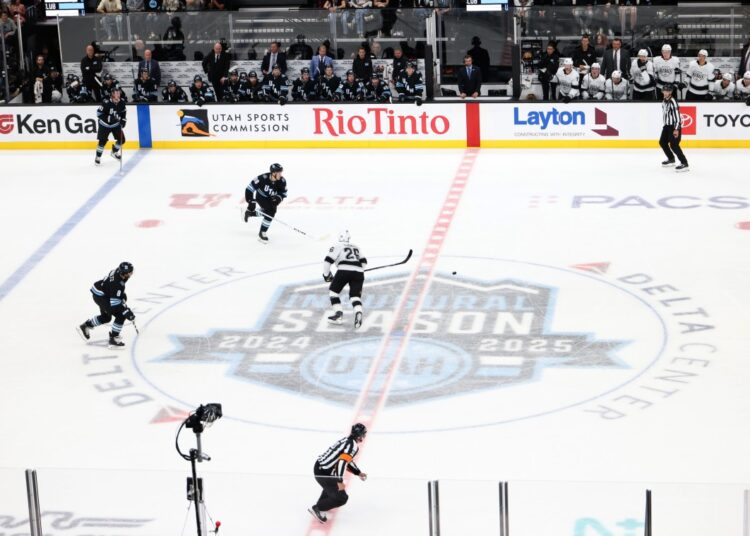Utah might be the new kid on the hockey block, but give the franchise and its ownership credit for already understanding one of the sport’s great axioms, often attributed to Walter Gretzky: skate to where the puck is going, not where it’s been.
In September, the franchise became one of a growing number of pro sports organizations to join the burgeoning trend of bringing the game directly to their fans. That came in the form of UtahHC+, a direct-to-consumer streaming service that, at a price point of $70 for the entire campaign, will put at least 75 of the franchise’s inaugural-season games onto fans’ devices. In doing so, Utah effectively cut out the burdensome middleman – there’s no need for fans to deal with a pesky cable provider – while creating a franchise-controlled platform on which their supporters can get their hockey fix.
Utah’s gambit comes at an interesting time in the sports-media landscape. The once-ubiquitous model for regional sports networks has faced a decline that was at first slow and then seemingly sudden. Major media conglomerates such as Warner Bros. Discovery have sold off their regional properties. Others have remained in the game as business has collapsed. Such is the case with Diamond Sports Group. Though the specter of bankruptcy looms, the company continues to own and operate the FanDuel Sports Network, formerly known as Bally Sports and Fox Sports Network. The company owns local broadcast rights to the likes of the Detroit Red Wings, Los Angeles Kings and Tampa Bay Lightning.
The launch of UtahHC+ also comes as teams and leagues have begun to invest more in streaming – and that includes the NHL itself. Though the league has long broadcast its games digitally and continues to offer league-wide streaming packages, the announcement of a two-year sub-licensing deal with Amazon and the subsequent launch of Prime Monday Night Hockey in Canada saw the NHL dive deeper into the streaming world. Asked about the decision to partner with the streamer, NHL commissioner Gary Bettman said it was a matter of reading the room. “The world’s moving away from cable TV,” said Bettman in mid-October. “Cord-cutting, cord-nevers continues, and the reach of cable and satellite is not what it was. The world, putting us aside, is moving towards other forms of distribution.”
That’s backed up by the numbers. A report from industry forecasters Digital TV Research noted a decline of more than four million paid television subscribers from 2023 to 2024 in the United States. In Canada, Converge Research reported that roughly four of 10 households didn’t subscribe to traditional cable by the end of 2023. And the forecasts aren’t rosy, either. By 2026, the latter report suggests half of Canada’s households will have ditched cable. The U.S. could arrive at that point by the end of this year, per Digital TV Research.
The departure from traditional cable, though, has created coverage gaps, and those gaps will inevitably increase. That’s true even for the supposed all-team, all-game services provided by ESPN in the U.S. and Sportsnet in Canada. Subscribers to those platforms aren’t free from blackout restrictions, where in-market broadcast-rights deals can leave hometown fans without a way to watch the local team. That’s where direct-to-consumer streaming comes in – and Utah isn’t the only franchise following the new model. In fact, due to circumstance, one NHL team was on the leading edge.
After the regional sports network serving Nevada was shuttered in April 2023, the Vegas Golden Knights became just the second ‘Big Four’ sports team to bring games directly to their fans, introducing KnightTime+ ahead of 2023-24. And Vegas has gone from test case to proof of concept.
Since KnightTime+ launched, the Florida Panthers have followed suit. The Dallas Stars and Anaheim Ducks, meanwhile, leverage a free streaming platform, Victory+, for viewers in their respective regions. As of this season, the Seattle Kraken are also broadcasting regional games on Amazon Prime. And there are another dozen NHL clubs whose local broadcasts are available via an organizational or multi-team streamer, such as MSG+, which provides local streaming access to the clubs in the NHL’s Tri-State area, or Altitude+, home of the Colorado Avalanche and NBA’s Denver Nuggets.
“Cord-cutting continues. The reach of cable and satellite is not what it was” – Gary Bettman
Adopting these team-centric platforms has an added benefit for fans, as some organizations have leveraged the in-house production to return to a classic method of delivering on-ice action: over-the-air broadcasting. To wit, fans in Utah, Vegas, Florida, Dallas, Anaheim and Chicago can watch each of their teams’ non-national broadcasts on television using an antenna. Yes, rabbit ears are back.
What this newfound shift toward direct-to-consumer streaming portends for the future remains to be seen. If – or when – those regional sports networks left standing begin to fall, more teams could follow suit, particularly south of the border. It’s unlikely to be the case in Canada, at least not for some time. The Bell-owned TSN and Rogers-owned Sportsnet control in-market Canadian broadcasts. The Calgary Flames and Edmonton Oilers, for instance, have agreements with Sportsnet through 2035. But as media corporations wrestle with new realities, it could just be that single-team streaming is the next big thing.
This article appeared in the Nov. 25, 2024, World Junior Championship issue of The Hockey News. In this edition, we feature wall-to-wall coverage of the 2025 World Junior Championship, complete with previews of all 10 teams plus some of the most prominent players involved. Also in this issue, we shine the spotlight on San Jose’s Tyler Toffoli, Philadelphia’s Travis Konecny and a team from Haida Gwaii that really goes the extra mile.
It’s available on newsstands now, or you can get it in print for free when you subscribe to The Hockey News at THN.com/Free today. All subscriptions include complete access to more than 76 years of articles at The Hockey News Archive.
Read the full article here


























Discussion about this post